Table of Contents
If you’ve ever dealt with international shipping or logistics, you’ve likely come across a shipping container number. Also known as a container identification number, this unique code is used to identify and track containers as they move across the globe. It’s like the ID tag for each cargo box helping businesses, ports, and carriers keep everything organized. In this article, we’re focusing on standard shipping containers, specifically the common 20-foot and 40-foot sizes. While there are many types of containers out there, the placement of the shipping container number can vary depending on the design. Just keep in mind that the information shared here applies to standard containers special types may have different layouts or markings.
Understanding these numbers is more important than it might seem. Whether you’re an importer, exporter, or just learning the ropes in logistics, knowing how container numbers work can help you:
✔ Track your shipment accurately – Always know where your cargo is, from departure to delivery. (Import & Export Process)
✔ Avoid costly mix-ups – Correct container identification prevents loading errors and delays.
✔ Speed up customs processing – A valid and clearly labeled container number ensures quicker inspections and fewer holdups.
What is a Shipping Container Number ?
A Shipping Container Number is a unique code assigned to every shipping container. This number plays a key role in global shipping, helping shipping companies, ports, and customers track and identify containers as they move across the world. It ensures that the right container reaches the right destination safely and on time. Container numbers are usually displayed in several places in the container, both exterior and interior.
Exterior Locations
- The container number is displayed clearly on the container doors, side panels, front panel, and sometimes on the roof panel.
- On the side panels and front panel, you may see the number written in horizontal or vertical layout, depending on the container owner’s design.
Interior Locations
- Inside the container, the number can be found on the first panel on the right-hand side, on the roof, or on the front wall.
- Just like on the outside, it can be displayed horizontally or vertically.
Most container numbers are shown using stickers, but in some cases, they are painted directly onto the metal panels. These markings help with easy identification during loading, unloading, inspections, and tracking.
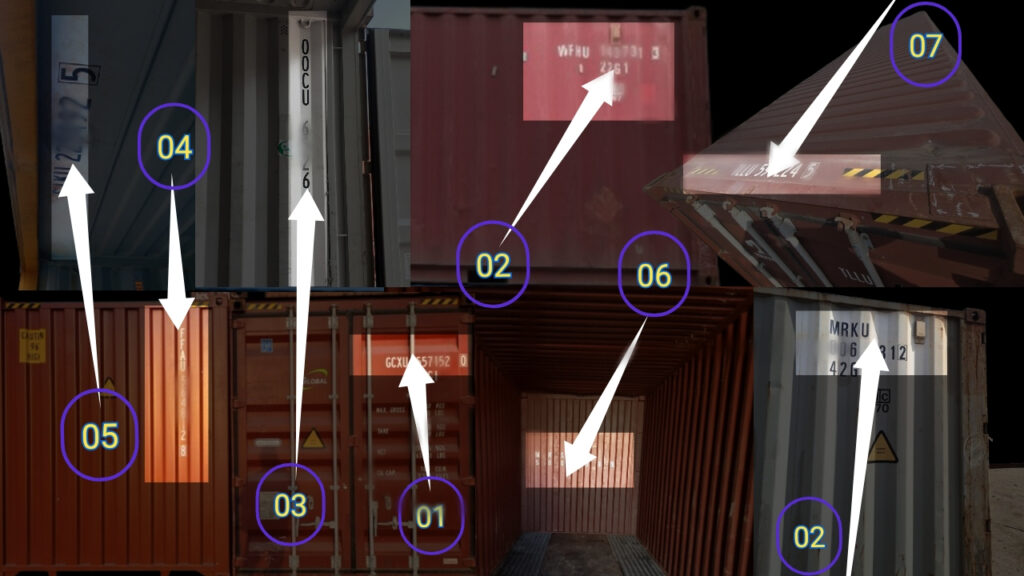
01. Door Panel – The most visible spot where the shipping container number is clearly displayed for quick access.
02. Side Panel – Often marked in large text, making the shipping container number easy to read from a distance.
03. Interior Side (Vertical Layout) – You’ll sometimes find the shipping container number printed vertically inside the container.
04. Front Exterior (Vertical) – The shipping container number may also appear vertically on the front exterior panel.
05. Interior Roof – Some containers include the shipping container number on the inside roof for internal reference.
06. Interior Front (Rare) – In rare cases, the shipping container number can be found on the front interior wall.
07. Exterior Roof – Occasionally, the shipping container number is marked on the roof for aerial or crane-side viewing.
Other Possible Places You Might See the Container Number
CSC Plate (Consolidated Data Plate)
- This metal plate includes technical details like weight limits, manufacturer info, and container identification number.
- The container number here is engraved or printed along with the container’s specs.
- Usually found on the left door of the container.
Corner Castings (Corner Fittings)
- In some containers, especially for customs or security use, the number may be engraved on Corner Castings ( Corner Fittings) for added security. This is helpful in case stickers are removed, damaged or missing.
Alternative Names for Shipping Container Numbers
- Shipping Container ID
- Shipping Container Identification Number
- Shipping Container Code
- Box Number (informal, often used in casual conversation or port-side operations)
- Shipping Container Serial Number
- ISO Container Number
- Equipment Number (especially when referring to it in the context of logistics systems or tracking platforms)
- BIC Code (refers to the Bureau International des Containers, especially the owner prefix part)
ISO 6346: The Standard Behind Shipping Container Numbers
Shipping container numbers aren’t just randomly assigned codes — they follow a strict international standard known as ISO 6346. This standard was developed by the International Organization for Standardization to ensure consistency in identifying containers across the global supply chain.
ISO 6346 defines how each container should be coded, identified, and marked. Whether a container is being loaded at a port in Asia or unloaded at a terminal in Europe, this standard ensures that it can be easily tracked and recognized anywhere in the world.
The latest version, ISO 6346:2022, continues to support the growing needs of intermodal transport by maintaining clarity and uniformity in container identification. Thanks to this globally accepted system, logistics providers, customs officials, and port authorities can all rely on a common language to manage container movements efficiently.
Structure of a Shipping Container Number
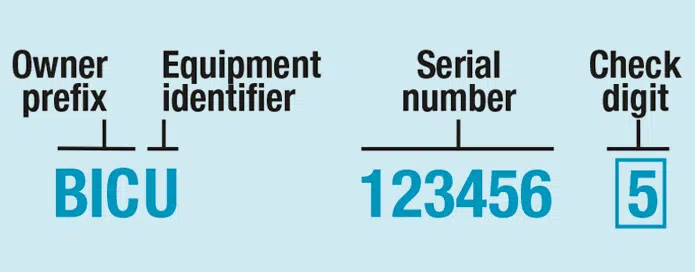
01. Owner Code (3 letters):
A shipping container number follows a standardized format used worldwide, making it easy to identify and track containers across ports and countries. This format is known as the container number structure, and it’s made up of four key parts:
The owner’s code is the first part of a shipping container number, made up of three capital letters. This short code identifies the company that owns or operates the container. According to the ISO 6346 standard, the owner’s code must be unique, consist of three capital letters, and be officially registered with the Registration Authority. This ensures that no two companies have the same code, helping avoid confusion in global container tracking.
Example: “MAE” might be used for Maersk, one of the world’s largest shipping lines.
1.1 Why is Registering the Owner Code Important?
- Ensures unique identification of the container owner.
- Supports customs clearance during international movement.
- Enables easier tracking and control across the supply chain.
1.2 Where and How to Register a Container Owner Code
If you want to get an official container owner code, you’ll need to go through the Bureau International des Containers (BIC) — the global body responsible for assigning and managing these codes.
1.3 CERTIFICATE OF REGISTRATION OF CONTAINER CODE
This is to certify that the container bearing the identification code [Container Number, e.g., ABCD1234567] has been duly registered in accordance with the International Convention for Safe Containers (CSC, 1972) and the regulations of [Issuing Authority/Country Name].
The above-mentioned container meets all required safety standards and is approved for international transport under the ownership of [Company Name/Operator].
Registration Number: [Registration ID]
Date of Issue: [DD/MM/YYYY]
Expiry Date: [DD/MM/YYYY]
Issuing Authority: [Name of Bureau/Organization]
Official Stamp/Signature: ___________________
CERTIFICATE OF REGISTRATION OF CONTAINER CODE – GLOBAL ORBIT MARINE
CERTIFICATE OF REGISTRATION OF CONTAINER CODE – MODALIS
1.4 How the Registration Works
- Fill out and submit an application to the BIC.
- Pay a one-time registration fee.
- Once approved, you’ll receive a unique 4-letter owner code.
- This code must then be clearly marked on your containers.
- To keep your code active, an annual renewal fee is required.
02. Equipment Category Identifier (1 letter):
The Equipment Category Identifier is represented by a single capital letter from the Latin alphabet, indicating the type of container or related equipment. The standard classifications are as follows:
| Letter | Meaning | Example |
|---|---|---|
| U | Standard shipping container – For all freight containers (including dry, refrigerated, tank, and other ISO-standard containers | MAEU = Maersk container |
| J | Detachable equipment (like a container’s removable part) | ABCJ = Attachable equipment |
| Z | Trailer or chassis (not a container itself) | XYZJ = Truck trailer |
If you see a number like TGHJ123456, the “J” means it’s not a full container—just a piece of equipment.
03. Serial Number (6 digits):
The serial number is a unique set of digits assigned to each container, acting almost like a fingerprint. No two containers under the same owner code will ever share the same serial number.
According to ISO 6346 standards, the serial number is made up of six Arabic numerals. If the actual number is shorter than six digits, zeroes are added at the beginning to make it six. For example, if a container’s number is 1234, it will be shown as 001234.
04. Check Digit (1 digit):
The Shipping Container Check Digit is the final number in the container number sequence. Its main job is to verify that the whole container number has been entered or transmitted correctly.
The check digit is calculated using a specific formula and helps catch mistakes when the number is keyed in, scanned, or shared across systems. It doesn’t just check the serial number — it also validates the owner code, equipment category identifier, and the serial number together, making sure the entire container number is accurate and reliable.
Having a check digit in place allows operators, terminals, depots, and others in the supply chain to quickly and automatically verify container numbers. It helps spot mistakes caused by manual typing errors or incorrect readings from OCR (optical character recognition) systems, making the entire process of container tracking and management much more accurate and efficient.
BIC Check Digit Calculator
How to Calculate the Check Digit for Container Number CSQU305438

Step 1: Assign Numerical Values
Each letter in the container prefix (CSQU) is assigned a specific numeric value based on the ISO 6346 standard.
The assignment begins with 10 for A, 12 for B, and so on (omitting multiples of 11).

Digits (0–9) in the serial number (305438) retain their original value.
Step 2: Apply Position-Based Multiplication
Next, each numeric value obtained in Step 1 is multiplied by 2 raised to the power of its position from left to right.
The first character is multiplied by 2⁰, the second by 2¹, the third by 2², and so on.
The multiplication factors grow exponentially as shown in the table below.

Step 3: Final Check Digit Calculation
Follow these final steps to determine the check digit:
a) Add all the results from Step 2.
b) Divide the total sum by 11.
c) Disregard any decimal places (keep only the integer part).
d) Multiply the resulting integer by 11.
e) Subtract the result of Step d) from the sum in Step a).


Shipping Container Number - Layouts
We can identify four types of shipping container identification layouts:
- Horizontal layout
- Vertical layout
- Alternative vertical layout (multiple columns)
- Alternative horizontal grouping layout
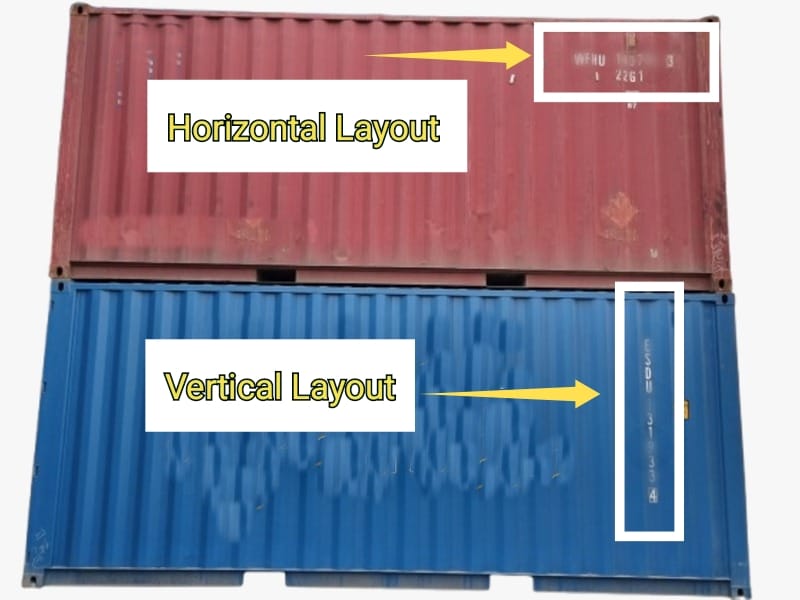
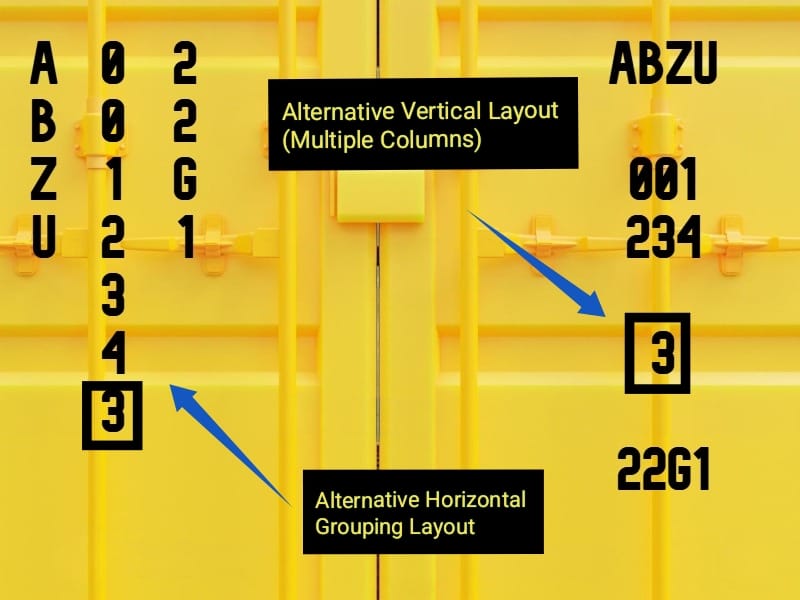
What is Shipping Container Prefix ?
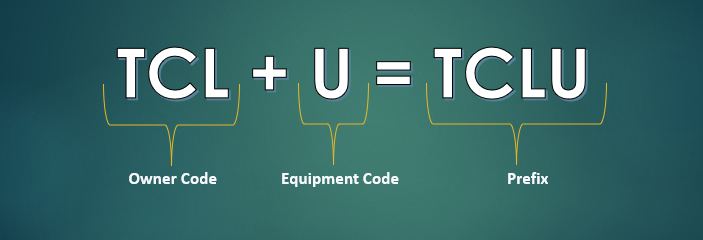
When you look at a shipping container number, the first four letters are called the shipping container prefix. This isn’t just a random set of letters it tells you two key things:
- 1. Who owns or leases the container (first 3 letters).
2. What type of equipment it is (4th letter).
Find Container Owner by Prefix or BIC Code
If you have a container number and want to identify the company that owns it, you can do so by checking the first four letters known as the owner prefix or BIC Code. To look it up, visit the official BIC Code search tool bic-code this site is managed by the Bureau International des Containers (BIC) and allows you to quickly verify which company a container belongs to using just the prefix.
What is the BIC Code in a container ?
The BIC Code (Bureau International des Containers Code) is a standardized identification system used globally to recognize container owners. It consists of four letters at the start of a container number (e.g., CSQU) and is registered with the BIC organization. This ensures international traceability and prevents duplication among container owners.
What’s the difference between a BIC Code and an Owner Code?
There is no difference—BIC Code and Owner Code refer to the same thing. Both terms describe the four-letter prefix that identifies the container’s registered owner under the ISO 6346 standard. The term “Owner Code” is often used in practical shipping and port operations, while “BIC Code” refers to the formal registration.
Who issues Owner Codes for containers?
Owner Codes are issued by the Bureau International des Containers (BIC). Companies must register their prefix with the BIC to ensure it is unique and recognized under international shipping regulations. This registration enables smoother tracking, customs processing, and digital integration across global trade systems.


